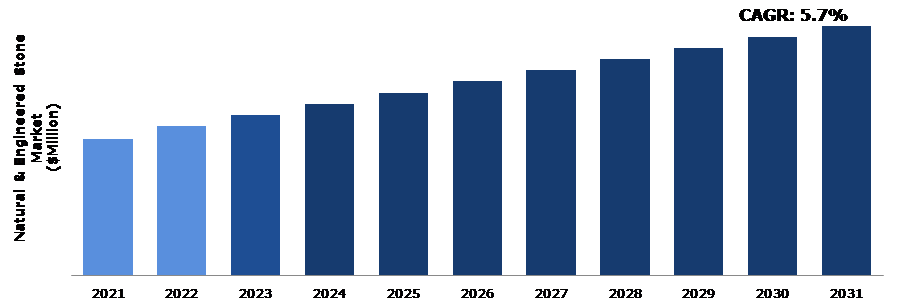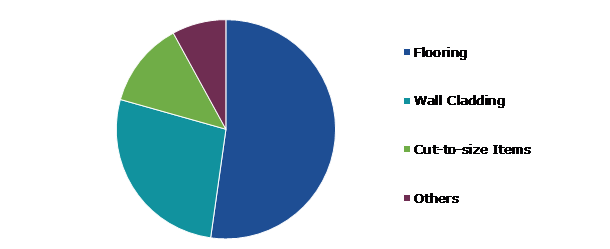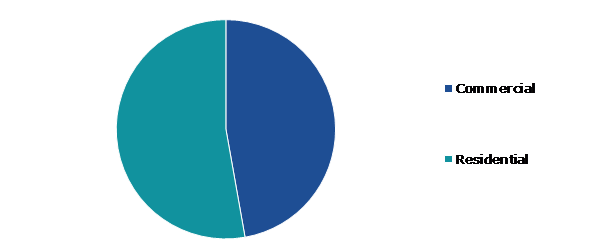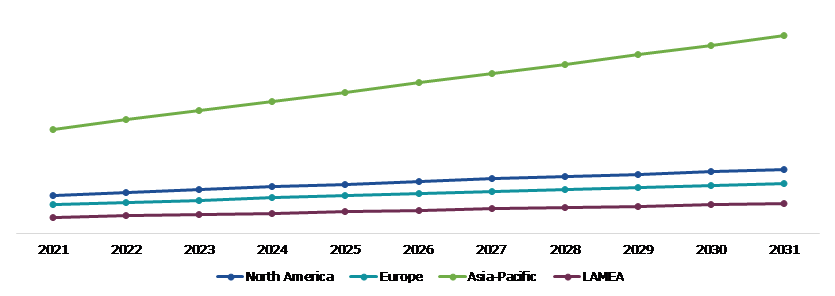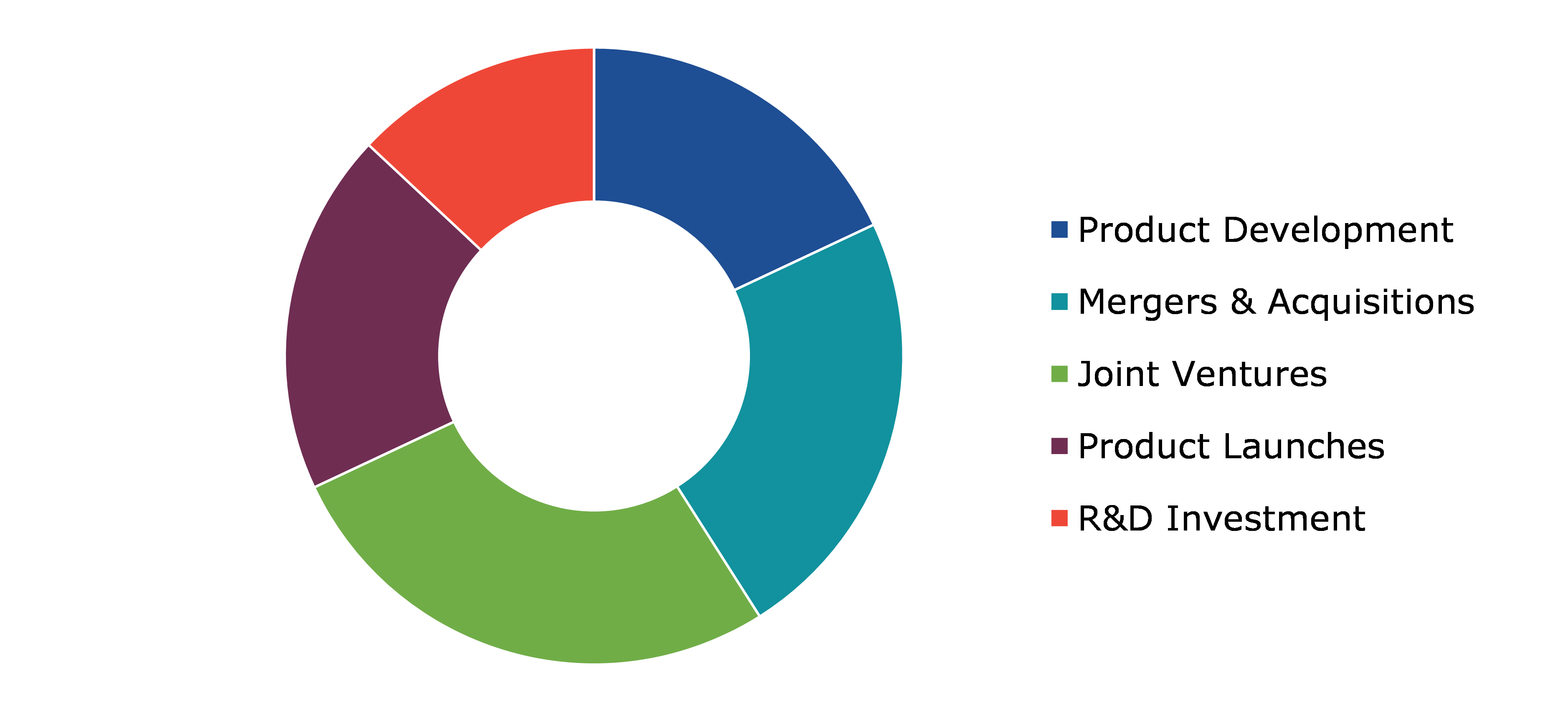Natural & Engineered Stone Market Report
RA08608
Natural & Engineered Stone Market by Type (Natural Stone (Granite, Marble, Limestone, Travertine, and Others) and Engineered Stone (Engineered Quartz, Polymer Concrete, Engineered Marble Stone)), Application (Flooring, Wall Cladding, Cut-to-size Items, and Others), End-use Industry (Commercial and Residential), and Regional Analysis (North America, Europe, Asia-Pacific, and LAMEA): Global Opportunity Analysis and Industry Forecast, 2022-2031
Global Natural & Engineered Stone Market Analysis
The Global Natural & Engineered Stone Market Size is predicted to be valued at $109,888.2 million by 2031, surging from $60,207.1 million in 2021, at a CAGR of 5.7%.
Market Synopsis
Natural stones are made up of complicated natural formations that use a variety of earth-quarried materials, including granite, limestone, quartzite, marble, slate, sandstone, onyx, and travertine. Since no two natural stones are exactly the same, natural stones are renowned for their distinctiveness, aesthetic appeal, texture, color, and composition. Natural stones are used in a wide variety of large-scale projects, including the construction of churches, governmental buildings, and monuments. Brick and wood were historically considered to be the only viable options for home construction projects. However, natural stone is now frequently used in residential construction due to its exceptional structural and aesthetic qualities. Natural stone is frequently used in residential constructions for fireplaces, countertops, baths, and entryways. Engineered stones, such as engineered quartz, find a wide range of uses in different areas, including residential buildings, flooring & wall cladding, and others. Engineered stones are highly strong and durable and have endless design potential. Due to all these factors, the natural & engineered stone market share is experiencing tremendous growth.
In natural stone, staining is the most common problem which occurs over time. Hence, it is important to regularly polish natural stone's surface. Also, bacteria can enter their holes and cracks as these stones are porous, making it challenging to clean the surface. These factors are expected to hinder the growth of the natural & engineered stone market growth during the forecast period.
Natural & engineered stones’ diverse properties, such as sturdy construction and beauty, are expected to increase the demand for these stones. Whether it is an architectural design structure like sculptures, natural & engineered stone enhances the elegance and attractiveness of the sculpture. Also, the methods employed by natural and engineered stone industry companies, such as acquisition, are revolutionizing the natural and engineered stone market. For instance, in April 2022, Evans Limestone, a renowned supplier of Indiana limestone, was acquired by Polycor Inc., a significant natural stone quarrier firm based in Canada. In addition, an increase in the import-export of natural & engineered stones is expected to create excellent growth opportunities for the key players operating in the market.
According to regional analysis, the natural stone & engineered stone market in Asia-Pacific is expected to generate considerable market share during the forecast period. The regional growth is attributed to growing construction activities and remodeling activities in both commercial and residential sectors which have boosted natural & engineered stone demand.
Natural & Engineered Stone Overview
Engineered stone is a material that is made out of crushed stone that has been bonded together using adhesive and other materials. These stones are available in a variety of colors, textures, and sizes. Also, these engineered stones can be customized according to the choice of the customer and requirements. Natural stones are well known for their beauty and the impression of peaceful tranquility they produce. Natural stones have aesthetic appeal in addition to being more durable than other building materials like wood, as they can be long-lasting without any maintenance.
COVID-19 Impact on Natural & Engineered Stone Market
The global crisis caused by the COVID-19 pandemic has negatively affected the natural & engineered stone market and brought real challenges to its functioning. For instance, to control the spread of coronavirus, the natural & engineered stone industry's activities, logistics, and administrative offices had to stop operating. The engineered stone manufacturers had to completely shut down their operations due to the lockdown that was imposed across several countries, which resulted in an economic crisis and job losses. The enterprises were unable to meet the demand from ongoing critical construction projects such as the construction of hospitals due to the lockdown and social distancing restrictions imposed by governments around the globe resulting in transportation limitations and employees' unwillingness to work. All these factors have negatively impacted the natural & engineered stone market size during the pandemic.
Increase in Construction Activities, Worldwide, to Drive the Market Growth
Rapid urbanization around the world is likely to drive the natural and engineered stone market growth. The need for homes and residential constructions has increased as a result of the population's rapid growth. Natural and engineered stones are used in a range of applications such as the interior of the home, including the kitchen, bathroom, living room, and others. Also, engineered stone is a great option for commercial applications like restaurants and hospitals because of its nonporous nature, and antibacterial and antifungal qualities. In addition, natural stones are incredibly strong and robust, making them a preferred stone for commercial projects like the construction of sculptures and renovations of old monuments and structures. For instance, according to a report published on March 22, 2022, by Digital Builder, an online magazine publishing information on buildings and construction work, approximately 1.55 million new house constructions are planned in the U.S., annually. All these properties and an increase in applications of natural stone & engineered stones are predicted to drive the natural & engineered stone market revenue growth in the upcoming years.
To know more about global natural & engineered stone market drivers, get in touch with our analysts here.
Porous Nature of Natural Stone & Various Chemical Compositions to Restrain Market Growth
Natural stone is extracted straight from mines in its natural state, resulting in a stone with varying chemical compositions and natural grain patterns. Natural stones tend to be porous and easily absorb stains. These natural materials need to be thoroughly sealed, and all of the pores in the stone need to be sealed with resins. The fragility and brittleness of some stones make them more prone to breaking and chipping. Some stones that break easily include onyx, travertine, and Italian marble. These factors are likely to hinder the natural & engineered stone market size growth during the forecast period.
Increase in the Use of Natural and Engineered Stones in Various Activities Such as Construction to Generate Enormous Opportunities
The building & construction sector has experienced remarkable growth because of the recent acceleration of urbanization, the development of smart cities, and the development of large-scale projects. In recent years, the building and construction industry has experienced substantial growth as a result of urbanization, smart city development, and construction megaprojects. In the residential and commercial sectors, natural stones like marble, granite, and others are frequently utilized for infrastructure projects, and rebuilding and renovation projects. One of the most widely utilized natural stones, marble is used to create a variety of items, including fireplaces, worktops, fountains, and kitchen countertops. The finest aesthetic option for kitchen countertops is marble, which is heat resistant to extreme levels, minimal maintenance, and is attractive. marble's most remarkable quality is that it allows for the utilization of strong colors without detracting from the room's overall design. All these factors are anticipated to create several growth opportunities for the major players operating in the market during the forecast period.
To know more about global natural & engineered stone market opportunities, get in touch with our analysts here.
Global Natural & Engineered Stone Market, by Type
Based on type, the market has been categorized into natural stone and engineered stone. Among these, the engineered stone sub-segment accounted for the highest market share in 2021 and is estimated to show the fastest growth during the forecast period.
Global Natural & Engineered Stone Market Size, by Type, 2021
Source: Research Dive Analysis
The engineered stone sub-segment generated the highest revenue in 2021. The engineered stone is further sub-segmented into engineered quartz, polymer concrete, and engineered marble stone. Engineered stone is made using quartzite, granite, or other natural stones, as well as a resin and color combination. Engineered slabs are composed of 90% crushed natural quartz and a trace of polyresin. Engineered stone offers several great properties in addition to being nonporous and immune to bacteria and viruses. Engineered stones can be made in large quantities and their non-porous nature allows them to be utilized in wet environments such as washrooms, pools, and bathtubs.
Global Natural & Engineered Stone Market, by Application
Based on the application, the market is further classified into flooring, wall cladding, cut-to-size items, and others. Among these, the flooring sub-segment accounted for a dominant market share in 2021.
Global Natural & Engineered Stone Market Share, by Application, 2021
Source: Research Dive Analysis
The flooring sub-segment accounted for a dominant market share in 2021. Natural stone flooring is created by cutting natural stone blocks into tiles. Marble, travertine, limestone, granite, quartzite, slate, and sandstone have been used in residential and commercial. As natural stone flooring is strong and beautiful, it is utilized for both indoor and outdoor flooring in homes and other structures. All these factors are anticipated to have a positive impact on the growth of the segment during the forecast period.
Global Natural & Engineered Stone Market, by End-use Industry
Based on the end-use industry, the market is further classified into residential and commercial. Among these, the residential sub-segment accounted for a dominant market share in 2021 and the commercial sub-segment is projected to have the fastest growth by 2031.
Global Natural & Engineered Stone Market Analysis, by End-use Industry, 2021
Source: Research Dive Analysis
The residential sub-segment accounted for a dominant market share in 2021. The sub-segment growth is mainly due to growing construction activities in the residential building sector. The demand for natural & engineered stones has increased significantly for residential building projects as engineered stones are less expensive. Also, engineered stones offer variations in color, texture, and size. All these factors are anticipated to drive the segment growth during the forecast time.
Global Engineered Stone Market, Regional Insights
The engineered stone market was investigated across North America, Europe, Asia-Pacific, and LAMEA.
Global Engineered Stone Market Size and Forecast, By Region, 2021 to 2031 ($Million)
Source: Research Dive Analysis
The Market for Engineered Stone in Asia-Pacific to be the Most Dominant and Show the Fastest Growth
The Asia-Pacific engineered stone market is expected to have a major market share during the forecast period. The need for engineered stones for flooring, wall cladding, civil works, and other uses is predicted to increase as building activities increase as a result of growing urbanization and industrialization in the region. The Asia-Pacific engineered stone market size is expected to increase due to the presence of major engineered stone-producing countries, including China and India. All these factors are anticipated to boost the demand for natural & engineered stone in Asia-Pacific during the forecast period.
Competitive Scenario in the Global Engineered Stone Market
Investment and acquisition are common strategies followed by major market players. For instance, Nuovvo, an engineered stone company, aims to develop and launched a newly engineered stone shower tray in 2022. The shower tray will be made entirely from engineered stone and intends to use nanotechnology in the manufacturing process.
Source: Research Dive Analysis
Some of the leading engineered stone market players are ARO Granite Industries Ltd., Dimpomar, Dermitzakis Bros S. A., Levantina Asociados de Minerales, S.A., Margraf Spa, LG Hausys, Johnson Marble & Quartz, Caesarstone Ltd., Cosentino S.A., and VICOSTONE.
| Aspect | Particulars |
| Historical Market Estimations | 2020 |
| Base Year for Market Estimation | 2021 |
| Forecast Timeline for Market Projection | 2022-2031 |
| Geographical Scope | North America, Europe, Asia-Pacific, and LAMEA |
| Segmentation by Type |
|
| Segmentation by Application |
|
| Segmentation by End-use Industry |
|
| Key Companies Profiled |
|
Q1. What is the size of the global natural & engineered stone market?
A. The global natural & engineered stone market is predicted to be valued at $109,888.2 million by 2031, surging from $60,207.1 million in 2021, at a CAGR of 5.7%.
Q2. Which are the major companies in the natural & engineered stone market?
A. ARO Granite Industries Ltd., Dimpomar, and Dermitzakis Bros S. A. are some of the key players in the global natural & engineered stone market.
Q3. Which region, among others, possesses greater investment opportunities in the future?
A. Asia-Pacific possesses great investment opportunities for investors in the future.
Q4. What are the strategies opted by the leading players in this market?
A. Investment and acquisition are the two key strategies opted by the operating companies in this market.
Q5. Which companies are investing more on R&D practices?
A. Levantina Asociados de Minerales, S.A., Margraf Spa, and Caesarstone Ltd. are the companies investing more on R&D practices.
1.Research Methodology
1.1.Desk Research
1.2.Real time insights and validation
1.3.Forecast model
1.4.Assumptions and forecast parameters
1.5.Market size estimation
1.5.1.Top-down approach
1.5.2.Bottom-up approach
2.Report Scope
2.1.Market definition
2.2.Key objectives of the study
2.3.Report overview
2.4.Market segmentation
2.5.Overview of the impact of COVID-19 on Global Natural & Engineered Stone market
3.Executive Summary
4.Market Overview
4.1.Introduction
4.2.Growth impact forces
4.2.1.Drivers
4.2.2.Restraints
4.2.3.Opportunities
4.3.Market value chain analysis
4.3.1.List of raw material suppliers
4.3.2.List of manufacturers
4.3.3.List of distributors
4.4.Innovation & sustainability matrices
4.4.1.Technology matrix
4.4.2.Regulatory matrix
4.5.Porter’s five forces analysis
4.5.1.Bargaining power of suppliers
4.5.2.Bargaining power of consumers
4.5.3.Threat of substitutes
4.5.4.Threat of new entrants
4.5.5.Competitive rivalry intensity
4.6.PESTLE analysis
4.6.1.Political
4.6.2.Economical
4.6.3.Social
4.6.4.Technological
4.6.5.Environmental
4.7.Impact of COVID-19 on Natural & Engineered Stone market
4.7.1.Pre-covid market scenario
4.7.2.Post-covid market scenario
5.Natural & Engineered Stone Market Analysis, by Type
5.1.Overview
5.2.Natural Stone
5.2.1.Definition, key trends, growth factors, and opportunities
5.2.2.Market size analysis, by region, 2021-2031
5.2.3.Market share analysis, by country, 2021-2031
5.3.Engineered Stone
5.3.1.Definition, key trends, growth factors, and opportunities
5.3.2.Market size analysis, by region, 2021-2031
5.3.3.Market share analysis, by country, 2021-2031
5.4.Research Dive Exclusive Insights
5.4.1.Market attractiveness
5.4.2.Competition heatmap
6.Natural & Engineered Stone Market Analysis, by End-use Industry
6.1.Commercial
6.1.1.Definition, key trends, growth factors, and opportunities
6.1.2.Market size analysis, by region, 2021-2031
6.1.3.Market share analysis, by country, 2021-2031
6.2.Residential
6.2.1.Definition, key trends, growth factors, and opportunities
6.2.2.Market size analysis, by region, 2021-2031
6.2.3.Market share analysis, by country, 2021-2031
6.3.Research Dive Exclusive Insights
6.3.1.Market attractiveness
6.3.2.Competition heatmap
7.Natural & Engineered Stone Market Analysis, by Application
7.1.Overview
7.2.Flooring
7.2.1.Definition, key trends, growth factors, and opportunities
7.2.2.Market size analysis, by region, 2021-2031
7.2.3.Market share analysis, by country, 2021-2031
7.3.Wall Cladding
7.3.1.Definition, key trends, growth factors, and opportunities
7.3.2.Market size analysis, by region, 2021-2031
7.3.3.Market share analysis, by country, 2021-2031
7.4.Cut-to-size Items
7.4.1.Definition, key trends, growth factors, and opportunities
7.4.2.Market size analysis, by region, 2021-2031
7.4.3.Market share analysis, by country, 2021-2031
7.5.Others
7.5.1.Definition, key trends, growth factors, and opportunities
7.5.2.Market size analysis, by region
7.5.3.Market share analysis, by country
7.6.Research Dive Exclusive Insights
7.6.1.Market attractiveness
7.6.2.Competition heatmap
8.Natural & Engineered Stone Market Analysis, by Region
8.1.North America
8.1.1.U.S.
8.1.1.1.Market size analysis, by Type, 2021-2031
8.1.1.2.Market size analysis, by End-use Industry, 2021-2031
8.1.1.3.Market size analysis, by Application, 2021-2031
8.1.2.Canada
8.1.2.1.Market size analysis, by Type, 2021-2031
8.1.2.2.Market size analysis, by End-use Industry, 2021-2031
8.1.2.3.Market size analysis, by Application, 2021-2031
8.1.3.Mexico
8.1.3.1.Market size analysis, by Type, 2021-2031
8.1.3.2.Market size analysis, by End-use Industry, 2021-2031
8.1.3.3.Market size analysis, by Application, 2021-2031
8.1.4.Research Dive Exclusive Insights
8.1.4.1.Market attractiveness
8.1.4.2.Competition heatmap
8.2.Europe
8.2.1.Germany
8.2.1.1.Market size analysis, by Type, 2021-2031
8.2.1.2.Market size analysis, by End-use Industry, 2021-2031
8.2.1.3.Market size analysis, by Application, 2021-2031
8.2.2.UK
8.2.2.1.Market size analysis, by Type, 2021-2031
8.2.2.2.Market size analysis, by End-use Industry, 2021-2031
8.2.2.3.Market size analysis, by Application, 2021-2031
8.2.3.France
8.2.3.1.Market size analysis, by Type, 2021-2031
8.2.3.2.Market size analysis, by End-use Industry, 2021-2031
8.2.3.3.Market size analysis, by Application, 2021-2031
8.2.4.Spain
8.2.4.1.Market size analysis, by Type, 2021-2031
8.2.4.2.Market size analysis, by End-use Industry, 2021-2031
8.2.4.3.Market size analysis, by Application, 2021-2031
8.2.5.Italy
8.2.5.1.Market size analysis, by Type, 2021-2031
8.2.5.2.Market size analysis, by End-use Industry, 2021-2031
8.2.5.3.Market size analysis, by Application, 2021-2031
8.2.6.Rest of Europe
8.2.6.1.Market size analysis, by Type, 2021-2031
8.2.6.2.Market size analysis, by End-use Industry, 2021-2031
8.2.6.3.Market size analysis, by Application, 2021-2031
8.2.7.Research Dive Exclusive Insights
8.2.7.1.Market attractiveness
8.2.7.2.Competition heatmap
8.3.Asia-Pacific
8.3.1.China
8.3.1.1.Market size analysis, by Type, 2021-2031
8.3.1.2.Market size analysis, by End-use Industry, 2021-2031
8.3.1.3.Market size analysis, by Application, 2021-2031
8.3.2.Japan
8.3.2.1.Market size analysis, by Type, 2021-2031
8.3.2.2.Market size analysis, by End-use Industry, 2021-2031
8.3.2.3.Market size analysis, by Application, 2021-2031
8.3.3.India
8.3.3.1.Market size analysis, by Type, 2021-2031
8.3.3.2.Market size analysis, by End-use Industry, 2021-2031
8.3.3.3.Market size analysis, by Application, 2021-2031
8.3.4.Australia
8.3.4.1.Market size analysis, by Type, 2021-2031
8.3.4.2.Market size analysis, by End-use Industry, 2021-2031
8.3.4.3.Market size analysis, by Application, 2021-2031
8.3.5.South Korea
8.3.5.1.Market size analysis, by Type, 2021-2031
8.3.5.2.Market size analysis, by End-use Industry, 2021-2031
8.3.5.3.Market size analysis, by Application, 2021-2031
8.3.6.Rest of Asia-Pacific
8.3.6.1.Market size analysis, by Type, 2021-2031
8.3.6.2.Market size analysis, by End-use Industry, 2021-2031
8.3.6.3.Market size analysis, by Application, 2021-2031
8.3.7.Research Dive Exclusive Insights
8.3.7.1.Market attractiveness
8.3.7.2.Competition heatmap
8.4.LAMEA
8.4.1.Brazil
8.4.1.1.Market size analysis, by Type, 2021-2031
8.4.1.2.Market size analysis, by End-use Industry, 2021-2031
8.4.1.3.Market size analysis, by Application, 2021-2031
8.4.2.Saudi Arabia
8.4.2.1.Market size analysis, by Type, 2021-2031
8.4.2.2.Market size analysis, by End-use Industry, 2021-2031
8.4.2.3.Market size analysis, by Application, 2021-2031
8.4.3.UAE
8.4.3.1.Market size analysis, by Type, 2021-2031
8.4.3.2.Market size analysis, by End-use Industry, 2021-2031
8.4.3.3.Market size analysis, by Application, 2021-2031
8.4.4.South Africa
8.4.4.1.Market size analysis, by Type, 2021-2031
8.4.4.2.Market size analysis, by End-use Industry, 2021-2031
8.4.4.3.Market size analysis, by Application, 2021-2031
8.4.5.Rest of LAMEA
8.4.5.1.Market size analysis, by Type, 2021-2031
8.4.5.2.Market size analysis, by End-use Industry, 2021-2031
8.4.5.3.Market size analysis, by Application, 2021-2031
8.4.6.Research Dive Exclusive Insights
8.4.6.1.Market attractiveness
8.4.6.2.Competition heatmap
9.Competitive Landscape
9.1.Top winning strategies, 2021
9.1.1.By strategy
9.1.2.By year
9.2.Strategic overview
9.3.Market share analysis, 2021
10.Company Profiles
10.1.ARO Granite Industries Ltd.
10.1.1.Overview
10.1.2.Business segments
10.1.3.Product portfolio
10.1.4.Financial performance
10.1.5.Recent developments
10.1.6.SWOT analysis
10.2.Dimpomar
10.2.1.Overview
10.2.2.Business segments
10.2.3.Product portfolio
10.2.4.Financial performance
10.2.5.Recent developments
10.2.6.SWOT analysis
10.3.Dermitzakis Bros S. A.
10.3.1.Overview
10.3.2.Business segments
10.3.3.Product portfolio
10.3.4.Financial performance
10.3.5.Recent developments
10.3.6.SWOT analysis
10.4.Levantina Asociados de Minerales
10.4.1.Overview
10.4.2.Business segments
10.4.3.Product portfolio
10.4.4.Financial performance
10.4.5.Recent developments
10.4.6.SWOT analysis
10.5.VICOSTONE
10.5.1.Overview
10.5.2.Business segments
10.5.3.Product portfolio
10.5.4.Financial performance
10.5.5.Recent developments
10.5.6.SWOT analysis
10.6.Margraf Spa
10.6.1.Overview
10.6.2.Business segments
10.6.3.Product portfolio
10.6.4.Financial performance
10.6.5.Recent developments
10.6.6.SWOT analysis
10.7.LG Hausys
10.7.1.Overview
10.7.2.Business segments
10.7.3.Product portfolio
10.7.4.Financial performance
10.7.5.Recent developments
10.7.6.SWOT analysis
10.8.Johnson Marble & Quartz
10.8.1.Overview
10.8.2.Business segments
10.8.3.Product portfolio
10.8.4.Financial performance
10.8.5.Recent developments
10.8.6.SWOT analysis
10.9.Caesarstone Ltd.
10.9.1.Overview
10.9.2.Business segments
10.9.3.Product portfolio
10.9.4.Financial performance
10.9.5.Recent developments
10.9.6.SWOT analysis
10.10.Cosentino S.A.
10.10.1.Overview
10.10.2.Business segments
10.10.3.Product portfolio
10.10.4.Financial performance
10.10.5.Recent developments
10.10.6.SWOT analysis
11.Appendix
11.1.Parent & peer market analysis
11.2.Premium insights from industry experts
11.3.Related reports
Interior design is a true representation of one's personality, and getting it right is difficult. The choice of stone is an important part of interior design because stone slabs are massive and fixed; once installed, they are unlikely to be changed anytime soon. Currently, there are various types of natural & engineered stone available in the market.
An engineered stone is also called agglomerated stone since it is made of quartz, resin binder, colours, quartzite, and additives. It is commonly used in fireplaces due to its extreme durability, heat and abrasion resistance, and heat resistance. Natural stone is a mineral found in mountains that includes slate, quartzite, sandstone, limestone, granite, marble, and others. It is mostly used in wall cladding and flooring for residential and commercial spaces due to its toughness, endurance, and attractive appearance. It is being widely used for monuments, statuary, and furniture. The global natural & engineered stone market is expanding at a rapid pace due to the rapid growth in construction projects that use stones in their structures.
Newest Insights in the Natural & Engineered Stone Market
The use of natural and engineered stones in construction and other activities has significantly increased in the past few years owing to their various benefits. As per a report by Research Dive, the global natural & engineered stone market is expected to surpass a revenue of $109,888.2 million in the 2022–2031 timeframe. The Asia-Pacific natural & engineered stone market is expected to perceive remarkable growth in the years to come. This is because the region has a massive demand for engineered stones in construction projects. Also, owing to rising urbanization and industrialization in this region the need for natural and engineered stones for flooring, civil works, wall cladding, and other uses is also increasing.
How are Market Players Responding to the Rising Demand for Natural & Engineered Stone?
Market players are heavily investing in novel research and inventions to cater for the rising demand for natural and engineered stones. Some of the foremost players in the natural & engineered stone market are Dimpomar, ARO Granite Industries Ltd., Dermitzakis Bros S. A., S.A., Levantina Asociados de Minerales, LG Hausys, Margraf Spa, Johnson Marble & Quartz, Cosentino S.A., Caesarstone Ltd., VICOSTONE, and others. These players are focused on planning and devising tactics such as mergers and acquisitions, collaborations, novel advances, and partnerships to reach a notable position in the global market. For instance:
- In January 2019, CFL Flooring, the biggest producer of rigid core, launched a new waterproof manufactured stone called Tenacity. With this launch, CFL Flooring is likely to grab a prominent position in the natural & engineered stone market.
- In June 2021, Omani-Indian Joint, a growth capital private equity firm with an emphasis on mid-market investments, announced the official launch of its new engineered quartz stone products production plant in the Sohar Free Zone.
- In May 2022, StoneLoads, a website where natural stone can be purchased and sold, announced the nationwide launch of their online natural stone marketplace, StoneLoads.com. Using the website, natural stone quarries and fabricators from all over the country can post whole truckload of products for sale by landscaping supply yards worldwide.
COVID-19 Impact on the Global Natural & Engineered Stone Market
The abrupt rise of the coronavirus pandemic in 2020 adversely impacted the global natural & engineered stone market. During the pandemic period, the logistics activities and administrative offices in the natural and engineered stone industries were forced to halt to curb the spread of the coronavirus. The lockdown that was enforced across numerous countries forced the manufacturers of engineered stone to stop operating, which resulted in economic calamity and job losses. Due to the transportation restrictions and employees' unwillingness to work, the natural and engineered stone providers were unable to meet the demand from ongoing important building projects such as the construction of hospitals. However, the natural & engineered stone market is expected to recover after the post-pandemic period due to rising development in construction industry across the globe.
Personalize this research
- Triangulate with your own data
- Request your format and definition
- Get a deeper dive on a specific application, geography, customer or competitor
- + 1-888-961-4454 Toll - Free
- support@researchdive.com

